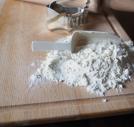Type 2 Diabetes Meal Plans
Meal plans help people consume the right amount of the right foods for optimum health.
For those with diabetes, meal plans assure the intake of a recommended amount of carbs per meal—generally 45 to 60 grams for men, and 30 to 45 grams for women. This judicious consumption of carbohydrates throughout the day is necessary for good glucose control. Two meal planning tools that help people with type 2 diabetes follow their carbohydrate guidelines - and get enough protein, dairy, and fats - are the “create your plate” and “list” methods.
Create Your Plate
Create your plate is an easy to implement glucose management and weight loss tool. It lets people select the foods they want, but encourages bigger helpings of non-starchy veggies, and smaller portions of starchy fare.
Anyone can create their plate by following these seven simple steps:
- On your dinner plate, mentally draw a vertical line down the middle. Then, on either the right or left side, draw a horizontal line dividing that section in half.
- Fill the largest plate section with non-starchy vegetables such as asparagus, broccoli, cucumber, onion, tomato, and Swiss chard.
- Use one of the smaller sections for grains and starchy items such as whole oats, brown rice, wild rice, potato, and quinoa.
- The remaining small section is for your protein foods such as lean meats, fish, legumes, lentils, peas, cheese, and eggs.
- Add a fruit or a dairy serving on the side - or have both - according to your dietary guidelines.
- Consume small amounts of healthy fats such as olive oil, vinaigrettes, seeds, nuts, and avocado.
- Round out your meal with a low-cal drink such as water, unsweetened coffee, or tea.
No weighing or carb counting is required. You can practice creating your plate using an interactive tool on the ADA website (link below). Or, consider planning your meals with food lists.
Food Lists and Exchanges
Using food lists is a more structured meal planning strategy. Food lists group together edibles that have the same amount of carbohydrate, protein, calories, and/or fat. A doctor or nutritionist will suggest how many servings per meal an individual can have from each of the lists (starches, fruits, dairy, non-starchy vegetables, meats, fats, and other carbs).
Each list’s food items are also called “exchanges” since they can be substituted for the other items on the same list. The exchange facilitates creative meal combinations. Some people find using food lists cumbersome as it requires counting and the use of measuring cups. However, the method works well for those who require a disciplined diet to control their blood sugar. The lists are available online (link below).
Use What Works
Your doctor or dietitian may recommend specific meal planning tools, but the only effective plan is one you are willing to follow, and works for you. If you are unhappy with your current planning method talk to your physician or diabetes care team about trying something different.
Source: ADA/Create Your Plate; Food Exchange List


































